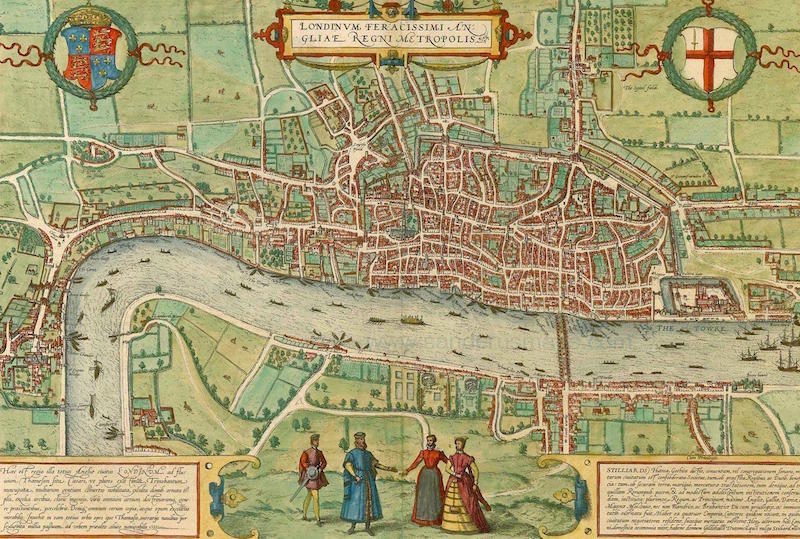NEIGHBORHOOD WALKING TOUR & MAP EXERCISEEach student will create a historical walking tour of a London neighborhood using Story Maps, an ArcGIS computer program. The tour will survey the ways in which that neighborhood has changed over the centuries and the most important historical events that took place there.
To begin the exercise, log in to Story Maps. Use the account you created during the information session in Watzek Library that was part of our program orientation last spring (or create a new account if you cannot access the old one). Click on "My Stories" followed by "Create Story" and then use the "Map Journal" function. Using Map Journal, you can begin to create your story map. Your narrative should explain the origins of your neighborhood’s name, describe the most important historical events that occurred there, list the most noteworthy residents and when they lived, trace the major demographic changes, and describe the most significant structural and environmental transformations that have characterized the area over time.
Your story map should be developed as a walking tour (i.e. along an actual route with specific beginning and end points). Your map should include at least five images, two excerpts from primary sources, and five narrative entries in your own writing (100-200 words each). Images may include old maps, illustrations, and photos—including your own. Excerpts from primary sources may include—but are not limited to—letters, diaries, passages from literature, government reports, Blitz accounts, newspapers, and magazines. All images and written sources must be properly cited.
In addition to historical mapping of the neighborhood in Story Maps, students must visit the various locations to plot out the route, survey the physical remnants of the local history, take photos, and identify the notable points along the way. You must select your neighborhood in consultation with the instructor (each student must choose a different area). See below for a list of some of London’s more distinctive neighborhoods.
The neighborhood walking tour and map exercise is due on November 19. The completed maps will be posted online.
 Battersea: Victorian industrial area, landmark power plant Battersea: Victorian industrial area, landmark power plant
 Bloomsbury: Early 20th-century literary and intellectual hub Bloomsbury: Early 20th-century literary and intellectual hub
 Brixton: Afro-Caribbean and African immigrant area Brixton: Afro-Caribbean and African immigrant area
 Camden Town: Victorian industrial area, London’s canal system, alternative music scene Camden Town: Victorian industrial area, London’s canal system, alternative music scene
 Chelsea: Bohemian center, hub of 1960s fashion, art, and music Chelsea: Bohemian center, hub of 1960s fashion, art, and music
 City of London: Roman settlement, medieval London, modern financial center City of London: Roman settlement, medieval London, modern financial center
 Covent Garden: Music, theatre, books and printing; Neoclassical architecture Covent Garden: Music, theatre, books and printing; Neoclassical architecture
 Docklands: shipbuilding and repair, postwar urban redevelopment Docklands: shipbuilding and repair, postwar urban redevelopment
 Ealing: British film industry Ealing: British film industry
 Greenwich: Naval and maritime history Greenwich: Naval and maritime history
 Kensington: Diplomatic and royal residences, Victorian public buildings Kensington: Diplomatic and royal residences, Victorian public buildings
 Kew: Botanical gardens and national archives Kew: Botanical gardens and national archives
 Kilburn: Irish and Afro-Caribbean immigrant area Kilburn: Irish and Afro-Caribbean immigrant area
 Knightsbridge: Luxury retail and hotel zone, foreign real estate investment Knightsbridge: Luxury retail and hotel zone, foreign real estate investment
 Lambeth: Medieval residential and commercial area, industrial center, war damage Lambeth: Medieval residential and commercial area, industrial center, war damage
 Mayfair: Wealthy residential area and retail shops, foreign real estate investment Mayfair: Wealthy residential area and retail shops, foreign real estate investment
 Mile End: Your local neighborhood! Mile End: Your local neighborhood!
 Notting Hill: Afro-Caribbean immigrant area (famous carnival) Notting Hill: Afro-Caribbean immigrant area (famous carnival)
 Paddington: Industrial rail development, historic hospital Paddington: Industrial rail development, historic hospital
 Shepherd's Bush: Eastern European immigrant area Shepherd's Bush: Eastern European immigrant area
 Soho: Social center; arts, leisure, music, theatre, and fashion Soho: Social center; arts, leisure, music, theatre, and fashion
 Southwark: Roman and medieval settlement, Shakespeare and Marlowe's London Southwark: Roman and medieval settlement, Shakespeare and Marlowe's London
 St. Giles: Site of an infamous Victorian "rookery" (slum) chronicled by Dickens St. Giles: Site of an infamous Victorian "rookery" (slum) chronicled by Dickens
 The Strand: Riverfront area on the Thames between the City and Westminster The Strand: Riverfront area on the Thames between the City and Westminster
 Westminster: Historic center of government, medieval abbey Westminster: Historic center of government, medieval abbey
 Whitechapel: Working-class Victorian neighborhood, historic Jewish community, 1888 Ripper murders Whitechapel: Working-class Victorian neighborhood, historic Jewish community, 1888 Ripper murders
|
The abovementioned neighborhoods are only a partial selection of potential sites for this assignment. Other possibilities include Bayswater, Belgravia, Chalk Farm, Clapham, Clerkenwell, Earl's Court, Finsbury Park, Fitzrovia, Fulham, Golders Green, Hackney, Islington, Marylebone, Muswell Hill, Hammersmith, Hampstead, Holland Park, Primrose Hill, Putney, Regent’s Park, Shoreditch, Wapping, Walthamstow, and White City.
|
|




